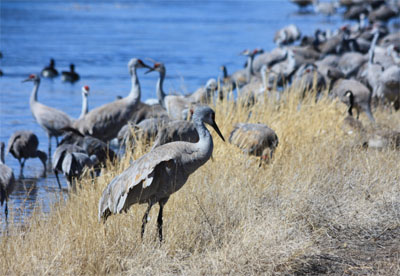
At the Friends of the Migratory Bird/Duck Stamp we emphasize the concept that the various units of the Refuge System, especially those acquired through Stamp dollars, form a vital network – that no refuge functions in isolation. A good example can be found out West in Region 6, where Alamosa and Monte Vista National Wildlife Refuges are situated in the San Luis Valley of south central Colorado. This valley constitutes the headwaters of the Rio Grande. About half of the two million acres of the valley is held by the public, in a mosaic of National Forests, National Parks, BLM lands, and other state and federal holdings, including one other NWR, Baca. The valley is cradled between two mountain ranges, the San Juans to the west and the sunset-kissed Sangre de Cristo Mountains to the east; its relatively flat floor lies at about 7,800 feet above sea level.
Alamosa NWR lies along the river and offers 12,026 acres of wet meadows, river oxbows, and riparian habitats: an oasis for wildlife in this dry region. Somewhat to the west, Monte Vista consists of 14,804 acres of artificial wetlands intensively managed for the benefit of waterfowl and other water birds. Monte Vista was organized as an NWR in 1952; 94% of its acreage has been acquired with MBCF/Stamp funds. The first deed for Alamosa was signed in 1963; 91% of its land can be credited to money from the MBCF.
The valley has a rich prehistory. We have evidence of human presence 12,000 years ago. About 7,500 years ago, the still-mobile populations began to build hunting blinds and storage structures. In the final millennium before European contact, the dwellers here became more sedentary, taking advantage of the valley’s wetland resources; pottery and archery flourished.
The unique hydrology of the region accounts in part for its value over the centuries to people. The groundwater of the San Luis Valley consists of an unconfined aquifer (one with a connection to surface waters in rivers and lakes) and below that, separated by an impermeable layer, a confined aquifer. Wells drilled into this confined aquifer are frequently artesian. It is recharged by precipitation and snowmelt from the enclosing mountains, and is buffered from short-term ebbs and flows.
The region’s system of water rights is even more complex than the flows of water that it regulates. Most of the senior water rights here go to irrigators. Monte Vista holds adjudicated water rights specifically for wildlife, which gives managers more flexibility. A key attribute of groundwater for legal purposes is whether it is considered tributary, that is, whether it has a direct hydraulic connection to surface waters. Surprisingly, both the unconfined and confined aquifers are tributary, although the confined aquifer’s connection to surface water is not fully understood by hydrologists.
As a reminder that the refuges are links in a chain of protected lands, perhaps the most stunning example in the San Luis Valley is the movement of Sandhill Cranes. During spring migration, the entire Rocky Mountain population of these birds – 20,000 strong – flies through the valley moving north from winter havens like Bosque del Apache NWR (featured in Wingtips in October 2013). It’s a journey of a day and half from the Bosque in New Mexico, as the crane flies. The cranes’ peregrinations are usually honored with an annual festival at Monte Vista in March.
Depending on the season and the location, waterfowl can abound at both refuges.
An important songbird that also benefits from this complex is the Southwestern race of Willow Flycatcher (Empidonax traillii extimus). Listed as Federally Endangered, this subspecies frequents willow thickets in the riparian habitats of Alamosa, as documented by the draft Comprehensive Conservation Plan.
Networks of partnerships are also important to the region. For example, the Colorado Wetlands Initiative has linked the Colorado Division of Wildlife, Colorado Parks and Outdoor Recreation, USFWS Partners for Fish and Wildlife, the Nature Conservancy, Great Outdoors Colorado, and Ducks Unlimited. In terms of public support and volunteers, the Friends of the San Luis Valley National Wildlife Refuges adds its help to all three refuges: Alamosa, Monte Vista, and Baca.
This National Wildlife Refuge profile first appeared in the 20 August 2015 issue of Wingtips.